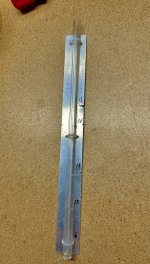Dan_E_Root
Active Member
Your local pilot shops and catalog stores offers graduated dip stick gauges for fuel measurement for $12.00 or so. The universal gauge even comes with calibration instructions.
Why anyone would pay so much for a plastic tube with some markings on it?
I thought graduated laboratory pipets would be a good alternaive, but only found them in glass or polystyrene. Glass breaks, and the polystyrene probably breaks down in gas. Not to worry, that well-known purveyor of plastics whose name rhymes with ZAP sells acrylic piping. It's the same material the store-bought gauges are made from. OK, the pipe from RHYMES WITH ZAP has a thinner wall, and it's not graduated, which explains why the commercial ones go so high. I'll grant that the thicker rod stock guages will be sturdier over time, and they're already marked. They're very nice, but come on, twelve bucks?
On the other hand, you can get six feet of 1/4 inch OD, 1/16 inch wall pipe for ONE DOLLAR. Cut it to size, and calibrate to fit your plane. For a dollar, heck, you'll have enough material left over to make a handful of them. If one breaks, there's another ready to go. Give 'em away as stocking stuffers, or use 'em as swizzle sticks. Meanwhile, your friends will have replaced that storebought one at least once because the guy who borrowed it, lost it!
whaddya think. will this work?
blue skies.
Why anyone would pay so much for a plastic tube with some markings on it?
I thought graduated laboratory pipets would be a good alternaive, but only found them in glass or polystyrene. Glass breaks, and the polystyrene probably breaks down in gas. Not to worry, that well-known purveyor of plastics whose name rhymes with ZAP sells acrylic piping. It's the same material the store-bought gauges are made from. OK, the pipe from RHYMES WITH ZAP has a thinner wall, and it's not graduated, which explains why the commercial ones go so high. I'll grant that the thicker rod stock guages will be sturdier over time, and they're already marked. They're very nice, but come on, twelve bucks?
On the other hand, you can get six feet of 1/4 inch OD, 1/16 inch wall pipe for ONE DOLLAR. Cut it to size, and calibrate to fit your plane. For a dollar, heck, you'll have enough material left over to make a handful of them. If one breaks, there's another ready to go. Give 'em away as stocking stuffers, or use 'em as swizzle sticks. Meanwhile, your friends will have replaced that storebought one at least once because the guy who borrowed it, lost it!
whaddya think. will this work?
blue skies.






